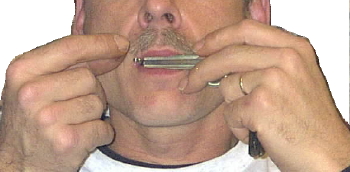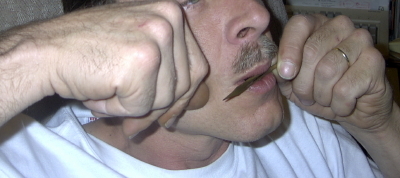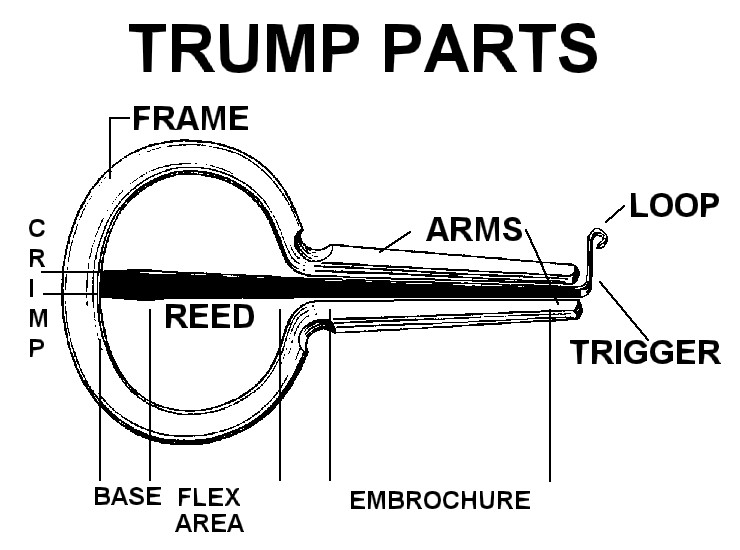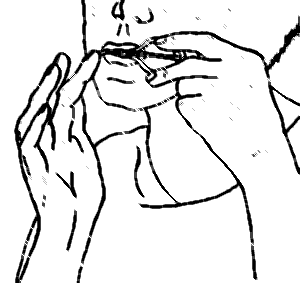| Typically held in the left hand by right handed people,
and plucked with the extended fingers of the right hand. The instrument is held firmly to
the players front teeth (no rattling allowed), with the trigger (refer to Figure 1)
pointing away from the player. When holding the steel frame it is important not to squeeze
the frame together reducing the space where the reed passes through the frame, thus
causing the reed to hit the frame. Try to hold the frame on its front and back rather than
it's sides. The players teeth should rest on the frame, with the
instrument pressed against them (refer to Figure 2). Do not bite down on the outside of
the frame. Your front teeth need to be spaced somewhat apart to allow the reed to pass in
and out without hitting the teeth. Until you are comfortable with this hold, PLUCK VERY
LIGHTLY. When plucking, keep the pluck in the same plane as the flexing of the reed. The
idea here is to not "tweak" the reed to the side while plucking which will cause
the reed to hit the frame. Sometimes we all hit the frame, it wont ruin the trump. It's
the annoying clinks that break up the music that need to be avoided. |
.jpg) Click to enlarge |
| The direction which you pluck is determined by the
instrument and personal preference. In Europe, an inward pull is used almost exclusively,
and some of the trumps reflect this in the shape of the trigger's tip. Many non-European
trumps have a full loop bent at the tip and can be plucked on the outward push stroke. If
your instrument does not have a loop, be careful with outward plucks as the underside of
these trigger tips are not always smooth enough to play this way. The loop can usually be
added by heating just the tip and rolling the end into a loop with very fine needle nose
pliers. There is a possibility that slight retuning may be required, or even that the tip
could break in the process, forcing major retuning. Be careful, but don't be afraid to try
this if you feel it is necessary for your playing style.
To play a variety of pitches and tones the player must alter the size
and shape of the mouth, and vary the air flow across the reed. Try "mouthing"
vowel sounds while plucking, or silently say the letter "K" with a big air push
. Try the whole alphabet. Try going from as big as you can get; tongue down, throat open;
to as small as possible with the tongue almost touching the reed. The mouth size is your
pitch range, while the vowel sounds are more of a tone quality palette. Experiment and
find the song within the instrument, and within you! |

|
BAMBOO TRUMPS
Karinding, Hoen Toong and other bamboo trumps are played with the pretty side facing
the audience. The holding hand FIRMLY holds the instrument with thumb and forefinger
opposing each other, very near but not interfering with the free end of the reed. This
firm clamping of the bamboo adds the mass. Holding the instrument more loosely will
diminish its volume.
The embouchure (best playing spot) generally occurs
at the free end of the reed, the last inch or so. This is where the reed is moving the
most and the fastest. Your thumb should be close to this area and may well rest against
your cheek.
The plucking hand produces sharp plucks, not necessarily
strong ones. The action is nearly percussive. A sharp release of the frame produces
the strongest tone, usually but not always pulling the frame toward the player. Rapid
forward and backward plucking is possible but difficult. The very straight pluck (in line
with the reed's flexing) as required with steel Trumps is not as critical. Plucking can
occur at some angle to the end, and the reed will not be driven to click against the
frame. This characteristic of bamboo trumps allows multiple finger plucks more easily than
steel. Spreading the fingers of the plucking hand and raking them across the end yields a
rapid succession of plucks.
While the volume of a Karinding is less than a good steel
Trump, the tone is unique and satisfying, though the sound decays rapidly.
BRASS TRUMPS

Brass trumps are like small, brass Karinding, and
are produced in a wide range of styles in many countries such as Laos, Vietnam and Tuva.
Some may be double or triple tongued. Most are small… even tiny, but the sound can be
big, or ethereal, or anywhere in between.
Holding and playing a brass trump is similar to
that of a Karinding, but with consideration of the reduced size and unique quality of the
individual instrument. The embouchure’s "sweet spot" can be quite small.
Once found, purse your lips around that area. This will enable you to use small amounts of
air to alter the sound of the trump. It may even be possible to "blow start" the
reed or keep the vibration "alive" for long periods. The mere act of flipping
the tip of your tongue will result in a large tremolo effect.
Plucking should be much softer than with a bamboo
trump. Many instruments may be designed to be plucked in a specific direction, usually
inward. Hold the wrist and elbow of the plucking arm in the same plane as the instrument
and use the index or middle fingers to softly stroke the trigger inward. More dexterous
players may be able to use several fingers in this way to produce multiple, fast plucks.
Directions for playing
Brass Trump Sets such as Dan Moi and Ho Ho
Spread the individual leaves apart into a fan.
Be sure the reeds don't hit the other trumps when plucked. It’s OK for the frame
areas to overlap a bit.
- Hold the group very firmly at the base where the wire ties the leaves
together. Keep thumb and finger from touching the moving reeds.
- Hold the group lightly to your lips, or just off the lips, and gently
pluck inwards with your free hand. The flat side of the trumps should face the audience,
Beware of getting facial hair caught in the reed.
- Open the mouth wide to play the group or less wide to play the
individual trumps. The four leaf set may be faned into two sets of two, allowing the pairs
to be played.
- When moving between trumps it is good to pull the group slightly off of
the lips, then reposition. Avoid sliding the instruments across the lips.
Forcing air across the trumps will increase volume and accent the fundamental, much
like a steel frame trump.
Website Design by M.D. Poss
Partner - Mouth Music
Last modified: July 2013 - Copyright 2013 - Mouth Music



.jpg)


